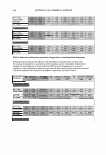382 5 4 20s G 20a H JOURNAL OF COSMETIC SCIENCE *** 30s 40s sos 60s Age-group (years) *** ** *** 30a 40a 50a 608 Age-group (years) Figure 1. (continued) □ caucuian □ Japanese □ caucaaian □ Japanese the lower eyelids of Caucasian females, marked lateral wrinkle formation from the lower area of the inner eye canthus was observed at a young age, and the mean wrinkle score almost reached a peak value of 5 in the group aged 40-49 years. Therefore, to assess wrinkles in this area, new criteria should be established. On the other hand, since photos with the eyes open were used in this study, there were some Caucasian subjects with wrinkles in the upper eyelid that could not be assessed. Shirakabe (10) reported that methods of cosmetic surgery differ between Westerners and Japanese due to differences in facial morphology. To make aged eyes look younger, he depresses the upper eyelids
AGE-RELATED FACIAL WRINKLING 383 Table IV Comparison of Lower Cheek Sagging Scores (mean± SD) Between Caucasian and Japanese Females Age group 20-29 30-39 4CH:9 50-59 60-69 Average Correlation coefficient 5 3 • 2 ' 00 1 0 20. Caucasian 1.06 ± 0.44 1.86 ± 0.65 2.82 ± 0.64 3.47 ± 0.74 4.19 ± 0.66 2.62 ± 1.26 r = 0.886 p 0.001 ** ** J 07 � . . . CXX) 30a 40a 50a Age-group (years) Sagging score Japanese 0.71 ± 0.61 1.42 ± 0.51 2.00 ± 0.68 2.50 ± 0.52 3.43 ± 0.51 2.01 ± 1.08 r = 0.875 p 0.001 ** � □ Caucasian □ Japanese 60a Figure 2. Comparison of the subzygomatic sagging scores between Caucasian and Japanese females. ***, **, *: p 0.001, 0.01, 0.05, respectively. in Westerners but, on the contrary, he reduces the depression of the eyes in Japanese. Therefore, different factors may be involved in age-related changes in the wrinkle morphology and sagging characteristics of each race. Garstein and Shaya (11) evaluated age-related changes in the total length of facial lines by two-dimensional analysis of wrinkles using photos of Caucasian females. They com pared two groups, one living in Seattle, Washington, who spent their time outdoors for five hours or less each day (low-UV-exposure group), and another group living in Tucson, Arizona, who spent their time outdoors for seven hours or more each day (high-UV exposure group). In that study, the total length of facial lines was significantly greater in the high-UV-exposure group than in the low-UV-exposure group in almost all age groups from 20-29 years to 60-64 years. Hillebrand et al. (12) analyzed age-related changes in the number and length of wrinkles identified in images of the faces of females aged 5-65 years. They compared Japanese females living in Kagoshima, located in the southern part of Japan, with those living in Akita, located in the northern part. They
Purchased for the exclusive use of nofirst nolast (unknown) From: SCC Media Library & Resource Center (library.scconline.org)






































































































